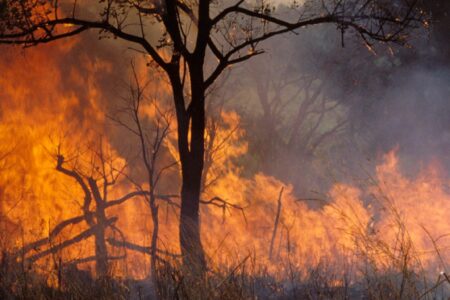Rome – The Food and Agriculture Organization of the United Nations (FAO) has released guidelines for countries outlining how to manage the risks of damaging wildfires, which can threaten people and the environment.
Integrated Fire Management Voluntary Guidelines: Principles and strategic actions updates previous FAO fire management voluntary guidelines that were published two decades ago and incorporates new content to address challenges stemming from the current climate crisis.
Extreme wildfires are projected to become about 50 percent more frequent by the end of the century and environmental changes linked to climate change, such as increased drought, high air temperatures and strong winds, are likely to result in hotter, drier, and longer fire seasons.
Currently, around 340 million to 370 million hectares of the Earth’s surface are burned by wildfire annually. When these wildfires become extreme, they can adversely affect sustainable development, threaten communities’ livelihoods, and generate large volumes of greenhouse gas emissions.
“How we respond to the wildfire challenge is of crucial importance,” said Zhimin Wu, Director of FAO’s Forestry Division, who launched the new edition of the guidelines at a side event during the 9th World Forest Week in Rome. “We must shift our focus from reactive responses to proactive strategies and prioritize prevention and preparedness.”
Integrating science and traditional knowledge
The guidelines emphasize the integrated fire management approach, which involves taking action long before, during, and long after a fire. It also recommends strategic actions to support the inclusion of Indigenous Peoples and other local knowledge holders, who contribute valuable, site-specific practices and insights that enhance fire management decisions. Their active engagement is crucial for preventing wildfires, promptly addressing fire outbreaks, and restoring areas devastated by severe burning, according to the publication.
Furthermore, the guidelines advocate for gender inclusion in integrated fire management, promoting diverse fire knowledge, innovative management options, and scaling up best practices.
Since the initial publication nearly 20 years ago, many countries around the world have used the FAO guidelines to develop public policies and training programmes. With the release of the second edition, even more countries are expected to reference and use the resource.
New specialized hub benefits from nearly $5 million in funding to combat wildfires
The release of the updated guidelines is the debut activity of the Global Fire Management Hub, which was launched in 2023 by FAO and UNEP. Supported by the governments of Canada, France, Germany, Portugal, the Republic of Korea and the United States of America, the Fire Hub aims to unite the global fire management community and enhance national capacities for implementing integrated fire management strategies.
During today’s side event, the Fire Hub announced that it had benefitted from nearly $ 5 million in funding since its launch in a crucial endorsement of its mission to reduce the adverse effects of wildfires on society, landscapes, and the global climate.
The funding comes from key partners who have been instrumental in the Fire Hub’s development, including the Canadian Forest Service, the German Federal Ministry of Food and Agriculture, the Korea Forest Service through the Assuring the Future of Forests with Integrated Risk Management (AFFIRM) Mechanism, the Portuguese Agency for Integrated Rural Fire Management, and the US Forest Service and USAID.

